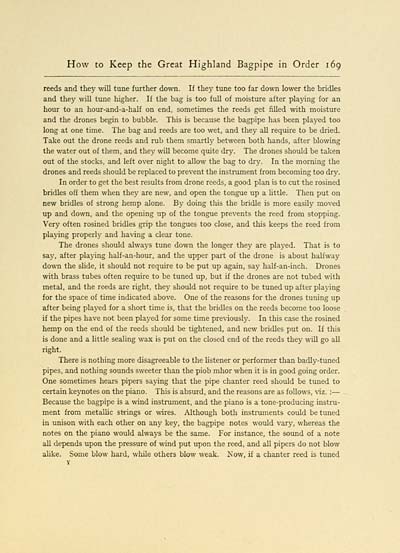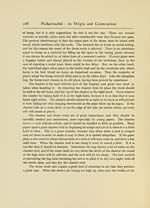Hew Morrison Collection > Piobaireachd
(175)
Download files
Complete book:
Individual page:
Thumbnail gallery: Grid view | List view

How to Keep the Great Highland Bagpipe in Order 169
reeds and they will tune further down. If they tune too far down lower the bridles
and they will tune higher. If the bag is too full of moisture after plajdng for an
hour to an hour-and-a-half on end, sometimes the reeds get filled with moisture
and the drones begin to bubble. This is because the bagpipe has been played too
long at one time. The bag and reeds are too wet, and they all require to be dried.
Take out the drone reeds and rub them smartly between both hands, after blowing
the water out of them, and they will become quite dry. The drones should be taken
out of the stocks, and left over night to allow the bag to dry. In the morning the
drones and reeds should be replaced to prevent the instrument from becoming too dry.
In order to get the best results from drone reeds, a good plan is to cut the rosined
bridles off them when they are new, and open the tongue up a Uttle. Then put on
new bridles of strong hemp alone. By doing this the bridle is more easily moved
up and down, and the opening up of the tongue prevents the reed from stopping.
Very often rosined bridles grip the tongues too close, and this keeps the reed from
playing properly and having a clear tone.
The drones should always tune down the longer they are played. That is to
say, after playing half-an-hour, and the upper part of the drone is about halfway
down the slide, it should not require to be put up again, say half-an-inch. Drones
with brass tubes often require to be tuned up, but if the drones are not tubed with
metal, and the reeds are right, they should not require to be tuned up after playing
for the space of time indicated above. One of the reasons for the drones tuning up
after being played for a short time is, that the bridles on the reeds become too loose
if the pipes have not been played for some time previously. In this case the rosined
hemp on the end of the reeds should be tightened, and new bridles put on. If this
is done and a little sealing wax is put on the closed end of the reeds they will go all
right.
There is nothing more disagreeable to the Ustener or performer than badly-tuned
pipes, and nothing sounds sweeter than the piob mhor when it is in good going order.
One sometimes hears pipers saving that the pipe chanter reed should be tuned to
certain keynotes on the piano. This is absurd, and the reasons are as follows, \dz. : —
Because the bagpipe is a wind instrument, and the piano is a tone-producing instru-
ment from metallic st-rings or wires. Although both instruments could be tuned
in unison with each other on any key, the bagpipe notes would vary, whereas the
notes on the piano would always be the same. For instance, the sound of a note
all depends upon the pressure of wind put upon the reed, and all pipers do not blow
aUke. Some blow hard, while others blow weak. Now, if a chanter reed is tuned
reeds and they will tune further down. If they tune too far down lower the bridles
and they will tune higher. If the bag is too full of moisture after plajdng for an
hour to an hour-and-a-half on end, sometimes the reeds get filled with moisture
and the drones begin to bubble. This is because the bagpipe has been played too
long at one time. The bag and reeds are too wet, and they all require to be dried.
Take out the drone reeds and rub them smartly between both hands, after blowing
the water out of them, and they will become quite dry. The drones should be taken
out of the stocks, and left over night to allow the bag to dry. In the morning the
drones and reeds should be replaced to prevent the instrument from becoming too dry.
In order to get the best results from drone reeds, a good plan is to cut the rosined
bridles off them when they are new, and open the tongue up a Uttle. Then put on
new bridles of strong hemp alone. By doing this the bridle is more easily moved
up and down, and the opening up of the tongue prevents the reed from stopping.
Very often rosined bridles grip the tongues too close, and this keeps the reed from
playing properly and having a clear tone.
The drones should always tune down the longer they are played. That is to
say, after playing half-an-hour, and the upper part of the drone is about halfway
down the slide, it should not require to be put up again, say half-an-inch. Drones
with brass tubes often require to be tuned up, but if the drones are not tubed with
metal, and the reeds are right, they should not require to be tuned up after playing
for the space of time indicated above. One of the reasons for the drones tuning up
after being played for a short time is, that the bridles on the reeds become too loose
if the pipes have not been played for some time previously. In this case the rosined
hemp on the end of the reeds should be tightened, and new bridles put on. If this
is done and a little sealing wax is put on the closed end of the reeds they will go all
right.
There is nothing more disagreeable to the Ustener or performer than badly-tuned
pipes, and nothing sounds sweeter than the piob mhor when it is in good going order.
One sometimes hears pipers saving that the pipe chanter reed should be tuned to
certain keynotes on the piano. This is absurd, and the reasons are as follows, \dz. : —
Because the bagpipe is a wind instrument, and the piano is a tone-producing instru-
ment from metallic st-rings or wires. Although both instruments could be tuned
in unison with each other on any key, the bagpipe notes would vary, whereas the
notes on the piano would always be the same. For instance, the sound of a note
all depends upon the pressure of wind put upon the reed, and all pipers do not blow
aUke. Some blow hard, while others blow weak. Now, if a chanter reed is tuned
Set display mode to: Large image | Transcription
Images and transcriptions on this page, including medium image downloads, may be used under the Creative Commons Attribution 4.0 International Licence unless otherwise stated. ![]()
| Early Gaelic Book Collections > Hew Morrison Collection > Piobaireachd > (175) |
|---|
| Permanent URL | https://digital.nls.uk/81166017 |
|---|
| Description | A selection of items from a collection of 320 volumes and 30 pamphlets of literary and religious works in Scottish Gaelic. From the personal library of Hew Morrison, the first City Librarian of Edinburgh. |
|---|
| Description | Selected items from five 'Special and Named Printed Collections'. Includes books in Gaelic and other Celtic languages, works about the Gaels, their languages, literature, culture and history. |
|---|

